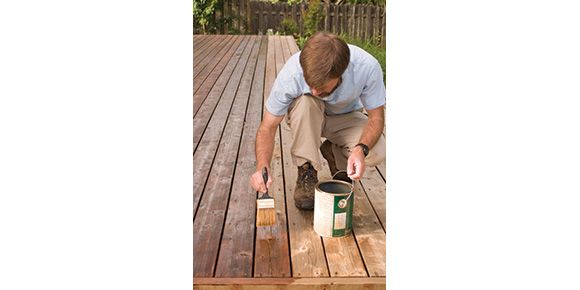Refinishing wood on a cottage deck is mandatory if you do not want the boards to turn gray. Despite claims by some stain manufacturers, there is not a product on the market that will withstand Manitoba’s harsh climate for more than two to three years before fading or peeling.
If you are one of those people who does not like the barn-board gray of a weathered deck, then be prepared to spend several days of your summer holiday removing old stain and preparing the surface for a fresh coat of lightly tinted oil or — the worst choice — a semi-transparent or solid product that contains pigment.
Horizontal surfaces lose their colour quickly because they are subjected to standing water and melting snow, as well as direct ultra-violet sun rays that combine with moisture to rapidly deteriorate stain and wood cells. This means deck boards, stair treads and railings are the first to fade or blister, depending on the type of stain used.
For those who insist on refinishing, there are products on the market that make the process a little easier by eliminating hand or machine sanding. Benjamin Moore sells a three-part system called Remove, Restore and Brighten. Remove is applied to a wet deck with a brush, roller or sprayer and should remain on the deck for about thirty minutes, then scrubbed off with a bristle brush and housed down. Restore can be applied in the same manner. It removes dead wood cells, mold and mildew responsible for graying deck planks. Brighten reverses the darkening effect of Restore on some woods, as well as cleaning the deck and preparing it to accept a new coat of stain by opening the wood’s pores clogged by dirt and organic debris from leaves and wind-borne particles.
For decks covered with several layers of peeling solid or semi-solid stains, sanding may be the only way to remove all the accumulated pigments. In such a case, it is easier on the back to rent a square-buff sander from a big-box store that can be operated in the standing position. Stay away from drum sanders because they take away wood unevenly, leaving round gouges that are visible when the wood is finished.
If there is only a small amount of pigment on the deck, it can often be removed with a palm, belt or pole sander with 60-grit paper. A power washer can be used to clean away sawdust; the spray is especially good for blowing out accumulated vegetation and other debris from spaces between deck boards.
Be careful when using a power washer as a needle-like high pressure spray can cut into wood like a laser. It’s best to take your time and use a wider spray that will not damage anything.
Some people claim that pressure washers are capable of removing paint pigment from wood, but my experience is that these machines are of limited use on badly blistered decks. Moreover, the high-pressure spray will fur or raise wood grain, necessitating sanding with 100-girt paper and a pole sander to smooth the surface before staining.
(There is another school of thought that suggests a furred surface will absorb more stain, therefore extending the colour and protective properties of the product for a longer period of time.)
For those who choose to re-stain their decks, my experience suggests that a tinted oil such as Penofin is far superior to products that contain pigments. It is a one-coat product consisting of Brazilian Rosewood oil available in three natural wood tints. It is formulated for pressure-treated lumber and will penetrate wood rather than sit on the surface like pigmented stains. Penofin is sold in Winnipeg by Park City Paints for about $55 per gallon.
The advantage to this type of stain is that when it begins to fade, the colour can be renewed by cleaning the deck with water and then adding a second coat. Moreover, the tinted oil highlights the natural figure of a wood deck instead of hiding it like pigment.
Finally, the oil can be used over top of a new pressure treated cedar-tone deck to enhance the colour and add extra protection from water and ultra-violet light.
Let pressure-treated wood dry for about three months before applying any stain.
As for my cottage decks, I’ve decided that gray is beautiful and I will allow them to turn gray naturally, like my hair.



